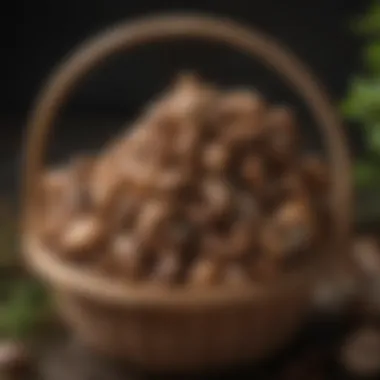Mastering Shiitake Mushroom Cultivation: A Complete Guide


Intro
Shiitake mushrooms (Lentinula edodes) are known for their rich flavor and potential health benefits. They have been cultivated and consumed for centuries, primarily in East Asia. Their growing popularity around the world makes understanding their cultivation an important topic. Proper techniques can lead to successful yields and sustainable practices.
In this guide, we will explore key concepts in shiitake mushroom cultivation. This will include terminology that is essential for understanding the process. We will also discuss historical contexts to give readers insight into how shiitake farming evolved. Various innovations and sustainable practices will be highlighted. The practical applications will feature step-by-step guides and real-life case studies to exemplify successful cultivation methods.
The aim of this article is to provide valuable information to both novice growers and experienced cultivators, focusing on optimizing growth conditions, managing pests effectively, and achieving a high yield without causing harm to the environment. Those engaged in agriculture, whether for personal use or commercial production, will benefit from the content provided.
Let’s begin by defining key concepts and terminology essential to shiitake mushroom cultivation.
Key Concepts and Terminology
Basic Definitions
Cultivating shiitake mushrooms requires an understanding of several fundamental terms. Here are a few key definitions:
- Mycelium: This is the vegetative part of the fungus. It consists of a network of filaments that absorb nutrients from the substrate.
- Substrate: The material on which mushrooms grow. Common substrates for shiitake include hardwood logs and sawdust.
- Fruiting: The process by which the mushroom emerges from the mycelium. This is when the visible part of the mushroom appears.
- Inoculation: This involves introducing mycelium into the substrate. It is a critical step in starting the cultivation process.
Understanding these terms is necessary for anyone looking to get started with shiitake mushroom cultivation.
Historical Context
Historically, shiitake mushrooms were first cultivated in Japan in the 12th century. They were known as "shiitake" because they were often found growing on the fallen leaves of shii trees. Over the centuries, cultivation practices spread throughout Asia and adapted to various environments and technologies.
In the past, cultivation methods were rudimentary, relying on natural forest conditions. However, with advancements in agriculture, many farmers began to experiment with controlled environments. This evolution has led to higher yields and more consistent production methods. Currently, shiitake mushrooms are produced globally, with significant contributions from countries like China, Japan, and the United States.
As we move forward in this guide, we will take a closer look at recent innovations and trends in shiitake mushroom cultivation.
Prelude to Shiitake Mushrooms
Shiitake mushrooms (Lentinula edodes) have garnered significant attention in culinary and agricultural sectors in the past decades. Their unique flavor and nutritional benefits make them a prized ingredient in various cuisines. Understanding their cultivation is essential not only for those wishing to produce them commercially but also for enthusiasts wanting to satisfy their culinary interests at home.
Shiitake mushrooms originate from East Asia, where they have been cultivated for centuries. This historical perspective is crucial as it sets the context for modern growing practices and innovations. Today, shiitake mushrooms hold a prominent position in the global market, commending a place in restaurants and households alike.
The benefits of cultivating shiitake mushrooms extend to health and nutrition. These mushrooms are rich in essential nutrients and bioactive compounds. The rich flavor they add to dishes coupled with their health benefits makes them an attractive choice for both consumers and growers. This article will explore the importance of various aspects of shiitake mushroom cultivation, laying a foundational understanding for efficient growing strategies and sustainable practices.
History and Origin
The cultivation of shiitake mushrooms dates back to the Tang Dynasty in China, around the year 600 AD. Initially, they were harvested from the wild under oak trees. Over time, cultivation practices evolved, and by the Edo period in Japan, dedicated methods for growing shiitake on logs were established. These practices have influenced modern cultivation techniques.
Shiitake mushrooms were introduced to other regions, leading to global demand. Today, countries like the United States and Canada are significant producers. Understanding this historical background helps in appreciating the efforts taken by growers worldwide to replicate and innovate upon traditional methods to enhance yield and quality.
Culinary and Nutritional Value
Shiitake mushrooms are highly regarded in culinary arts for their rich flavor, often described as earthy and savory. They can be used in numerous dishes, from soups to stir-fries, and they pair well with a variety of ingredients. Their ability to enhance the overall taste of dishes cannot be overstated.
Nutritionally, shiitake mushrooms offer a wealth of health benefits:
- Rich in vitamins and minerals: Shiitake are a good source of B vitamins such as B2, B5, and B6, alongside important minerals like copper and selenium.
- High in polysaccharides: These compounds are known for their immune-boosting properties, potentially aiding in disease prevention.
- Low in calories: This makes shiitake mushrooms an excellent option for those looking to maintain a healthy diet while adding flavor.
"Shiitake mushrooms not only enhance culinary experiences but also contribute to health, making their cultivation a valuable endeavor."
Overall, the exploration of shiitake mushrooms in this guide is essential for anyone interested in understanding their cultivation, cuisine, and nutrition. It serves as a vital starting point for enhancing agricultural practices and culinary skills.
Understanding Shiitake Growth Requirements
The success of shiitake mushroom cultivation hinges significantly on understanding the growth requirements. Knowing the optimal environment can greatly enhance yield quality and quantity. Various components, such as temperature, humidity, and light, play pivotal roles in promoting healthy growth. Failing to provide the right conditions can lead to poor harvests or even complete crop failure. Therefore, grasping these requirements is crucial for both novice and experienced cultivators.
Ideal Temperature Parameters
Shiitake mushrooms thrive in a specific temperature range that varies throughout their growth stages. Generally, the ideal temperature for mycelial colonization is between 23°C and 26°C (73°F to 79°F). During fruiting, they prefer slightly cooler temperatures, ideally around 13°C to 20°C (55°F to 68°F). This difference is essential to trigger the fruiting process.
To monitor and maintain these parameters, growers can use thermometers or digital sensors. Any significant fluctuations can stress the mushrooms, leading to suboptimal growth. Adjustments can be made through insulation techniques or environmental controls, ensuring a stable climate during the cultivation process.
Humidity and Airflow Considerations
Humidity is another vital factor in shiitake cultivation. Ideal humidity levels range from 85% to 95% during fruiting, with lower humidity levels during the mycelium colonization phase. Proper humidity not only informs the development of the fruiting bodies but also protects against contamination.
To achieve appropriate humidity, growers can use humidifiers and misting systems. It is also important to have good airflow to prevent stagnant air, which can promote fungal diseases. Airflow can be managed using fans or vents. Continuous monitoring of these aspects is vital to foster a suitable environment for mushrooms to flourish.


Light Needs for Shiitake Cultivation
Unlike some other fungi, shiitake mushrooms do not require intense light to grow. However, a small amount of indirect light is beneficial, particularly during the fruiting stage. Light helps to signal the mycelium to start the fruiting process, resulting in better quality mushrooms.
Generally, 12 hours of light per day is sufficient. Soft light sources, such as fluorescent lights, are preferable. Avoiding strong direct sunlight can prevent overheating and damage to the mushrooms. Understanding these light needs can lead to more uniform growth and higher-quality yields.
Maintaining optimal growth conditions is not just about yield; it is about the overall health of the mushrooms and sustainability in cultivation.
Selecting the Right Substrate
Selecting the right substrate is fundamental in shiitake mushroom cultivation. The substrate serves as both a source of nutrients and a medium for the mushrooms to grow. The choice of substrate influences not only the quality of the harvest but also the overall success of the cultivation process. It is essential to understand different types of substrates, their nutritional needs, and the best preparation methods to ensure optimal growth.
Types of Suitable Substrates
Shiitake mushrooms can thrive on several substrates, which can be divided into natural and artificial options. Natural substrates include hardwood logs, such as oak and maple. These materials are rich in lignin, which is essential for shiitake growth.
In addition to natural options, artificial substrates created from agricultural waste have gained popularity. Some suitable materials are:
- Sawdust: Often combined with supplements to enhance nutrition.
- Straw: Requires careful management of moisture content.
- Coffee grounds: High in nitrogen and easily accessible.
Choosing the right substrate can significantly impact mushroom yields and growth rates, so it is essential to select based on availability and cost-effectiveness.
Nutritional Requirements of the Substrate
The nutritional content of the substrate is crucial for shiitake mushrooms. Key nutrients include carbon, nitrogen, and essential minerals.
- Carbon: Found mainly in the cell walls of plant materials, it provides energy for growth.
- Nitrogen: Important for building proteins and enzymes, it can be supplemented through compost or organic fertilizers if not sufficient in the substrate.
- Minerals: Elements like calcium, magnesium, and potassium also contribute to healthy mushroom development. Monitoring the balance of these nutrients is vital as deficiencies can lead to poor yields and disease susceptibility.
Preparation and Pasteurization Techniques
Proper preparation of the substrate is crucial for preventing contamination and promoting healthy growth. The following steps are commonly recommended:
- Moistening: Ensure the substrate is adequately moist, usually around 60-70% water content, which facilitates fungal growth.
- Pasteurization: This eliminates unwanted microorganisms. Effective methods include:
- Cooling: Allow the substrate to cool down before inoculation with shiitake spawn to avoid thermal stress on the new mycelium.
- Hot Water Pasteurization: Soaking the substrate at 60 to 75 °C for 30 minutes.
- Steam Pasteurization: Exposing the substrate to steam for an equivalent time.
By carefully selecting and preparing the substrate, cultivators can optimize conditions for shiitake growth, leading to higher yields and better overall production efficiency.
Cultivation Methods
Understanding cultivation methods is crucial for anyone interested in shiitake mushroom farming. These methods dictate the success rate of mushroom production, the quality of the harvest, and the overall efficiency of the growing process. Selecting the right cultivation technique can lead to bountiful yields while minimizing waste and labor.
When exploring cultivation methods, factors like available space, resources, and desired scale of production play significant roles. Familiarity with various approaches, such as log and bag cultivation, empowers farmers to optimize their practices based on individual circumstances.
Log Cultivation Techniques
Log cultivation of shiitake mushrooms is a traditional practice that many growers appreciate. It involves inoculating hardwood logs—commonly oak, maple, or beech—with shiitake spores or mycelium. This method is beneficial for small-scale growers who have access to logs and desire a natural growing process.
Key steps in log cultivation include:
- Choosing logs: It is essential to select healthy, freshly cut logs to ensure the best results. Logs should ideally be between 3-8 inches in diameter and cut in late winter or early spring.
- Inoculation: Using a drill, holes are made in the logs, where the shiitake spawn is inserted. It is crucial to ensure proper placement and sealing to foster mycelial growth.
- Incubation period: Logs should be stored in a shaded area for approximately six months, allowing the mycelium to colonize the wood fully.
- Harvesting: Once fully colonized, logs can produce mushrooms for several years, requiring minimal maintenance.
Log cultivation yields flavorsome shiitake mushrooms and offers an eco-friendly solution for farmers looking to cultivate sustainably.
Bag Cultivation Methods
Bag cultivation is a modern and efficient method popular among larger growers. In this system, shiitake mycelium is cultivated in plastic bags filled with a nutrient-rich substrate. This method allows for greater control over environmental conditions, making it suitable for commercial production.
The process involves:
- Substrate preparation: Common substrates for bag cultivation include sawdust, wheat bran, and rice hulls. The combination of materials must provide sufficient nutrition for the mushrooms.
- Inoculation: Similar to log cultivation, the substrate is inoculated with shiitake spawn, usually following pasteurization or sterilization procedures to eliminate competing microorganisms.
- Controlled environment: The bags should be stored in a climate-controlled area, often facilitating optimal temperature and humidity for faster colonization.
- Harvesting: After about one to two months, the mushrooms will begin to fruit, allowing for multiple flushes over the growing season.
This method is advantageous due to its scalability and adaptability to varying markets.
Commercial Scale Production
Commercial scale production of shiitake mushrooms combines both log and bag cultivation technologies, using large systems designed for high output. Enterprises adopting this method can provide for a broader market base while sustaining quality.
The benefits of commercial scale shiitake production include:
- Automation: Many processes can be automated, such as pasteurization, inoculation, and environmental control, leading to higher efficiency and lower labor costs.
- Consistent quality: With controlled conditions and optimized protocols, producers can ensure consistency in product size and flavor, appealing to distributors and consumers.
- Focused research: Engaging in commercial production allows businesses to invest in research and development, discovering innovative practices and technology to enhance yields and sustainability.


In understanding and selecting effective cultivation methods, the shiitake mushroom practitioner not only enhances their yields but also contributes to broader sustainability in agriculture.
Pest and Disease Management
Pest and disease management is a critical aspect of shiitake mushroom cultivation. As with any agricultural endeavor, cultivators face risks that could compromise their yield and overall quality. Effective management strategies not only help in protecting mushrooms from pests and diseases but also extend their viability and market value. Therefore, addressing these issues is essential for anyone serious about mushroom farming.
Common Pests Affecting Shiitake Mushrooms
Several pests can threaten shiitake mushroom crops. Understanding these pests is the first step in managing them effectively. Here are some of the most common:
- Mushroom Fly: These insects lay eggs on fruiting bodies and larvae feed on the mushrooms, leading to deformation and decay.
- Mites: Mites can cause damage to the mushroom's growing tissue, resulting in reduced yield and quality.
- Slug: Slugs are known for eating the mycelium and emerging mushrooms, particularly in humid environments.
- Fungal Gnats: Similar to mushroom flies, gnats can introduce diseases and hinder healthy growth.
Natural predators and traps can be effective for controlling these pests. Regular monitoring is recommended to detect pest infestations early.
Diseases and Their Impact on Yield
Diseases pose a significant threat to shiitake mushrooms, as they can devastate entire crops. The two primary disease categories to consider are fungal and bacterial infections.
- Fungal Infections: These can result in conditions like green mold and wet bubble disease. They can spread rapidly and severely affect yield.
- Bacterial Infections: These often result in mushy mushrooms and can carry over to future crops, leading to contamination and a decline in overall health.
The impact these diseases have on yield can be drastic. Losses may reach up to 60% in severe cases. Therefore, understanding how conditions contribute to disease progression is vital for prevention.
Integrated Pest Management Strategies
Integrated Pest Management (IPM) offers a holistic approach to pest and disease management. This method combines cultural, biological, and chemical controls for optimized results. Here are key strategies:
- Cultural Controls: Maintain cleanliness in growing areas, ensure good ventilation, and practice crop rotation. These actions can dramatically reduce the risk of pests and diseases.
- Biological Controls: Use beneficial organisms to naturally control pest populations. For instance, introducing beneficial nematodes can help manage fungal gnat larvae.
- Chemical Controls: When necessary, apply suitable fungicides or insecticides as a last resort. The aim should be to minimize chemical use to maintain a sustainable farming practice.
The key to a successful pest management strategy lies in prevention, monitoring, and sustainable practices that nurture the equilibrium within the cultivation ecosystem.
By adopting these strategies, farmers can foster healthier environments for shiitake mushrooms, ultimately leading to improved yields and quality.
Harvesting Shiitake Mushrooms
Harvesting shiitake mushrooms is a critical aspect of the cultivation process. This stage not only determines the quality and yield of the mushrooms but also affects the economic viability of the entire growing operation. Knowing when and how to harvest shiitake mushrooms can enhance flavor, texture, and market appeal. Experienced cultivators understand that proper harvesting techniques lead to higher quality produce and can minimize waste.
When to Harvest for Optimal Quality
The timing of the harvest significantly influences the final product. Shiitake mushrooms should be harvested when the caps begin to open and are still firm. The gills beneath the cap should be visible but not fully exposed. This point is crucial as harvesting too early can result in less flavor, while waiting too long can lead to over-mature mushrooms that are tough and lacking in taste.
To determine the right time for harvesting:
- Observe the size of the mushrooms. They should ideally reach around three to five inches in diameter.
- Monitor the cap texture. Firm caps indicate freshness and quality.
- Check the gills. If they are still slightly covered by the cap, it is likely the right moment for harvest.
Harvesting at this stage usually occurs about 7 to 14 days after the mushrooms appear.
Techniques for Harvesting
Proper harvesting techniques not only ensure the quality of the shiitake mushrooms but also maintain the health of the underlying mycelium for future yields. Here are some effective methods for harvesting:
- Twist and Pull Method: Gently twist the mushroom at the base where it meets the log or substrate and pull upwards. This method helps minimize damage to surrounding mushrooms.
- Cutting with a Knife: Use a clean, sharp knife to cut the stem of the mushroom at its base. This technique is beneficial for larger mushrooms or when a precise cut is necessary to avoid damaging neighboring fungi.
"Proper harvesting preserves the integrity of the mycelium and allows for subsequent flushes of mushrooms to grow effectively."
- Avoiding Moisture: Handle mushrooms with dry hands and store them in breathable containers to prevent condensation. This helps maintain their texture and prevents spoilage.
Through these harvesting techniques, cultivators can maximize the quality of the shiitake mushrooms while ensuring that future harvests remain plentiful. After harvesting, it is essential to move on to post-harvest handling quickly to preserve the mushrooms' freshness and flavor.
Post-Harvest Handling and Storage
Post-harvest handling and storage of shiitake mushrooms are critical steps that significantly influence quality, shelf life, and overall marketability. Once harvested, shiitake mushrooms can quickly degrade if not managed properly. This section delves into key aspects of post-harvest practices, emphasizing the importance of effective handling and storage methods.
Best Practices for Storage
To maintain the quality of harvested shiitake mushrooms, the following practices should be implemented:
- Harvesting at the Right Time: Timing is crucial. Mushrooms should be picked when caps are still firm and moist.
- Temperature Control: Store mushrooms in a cool, dark place. Ideal storage conditions typically range between 32°F and 36°F (0°C to 2°C). This temperature slows down enzymatic activity, inhibiting spoilage.
- Use of Containers: Utilize breathable containers, such as cardboard boxes or perforated plastic bags. This setup allows for airflow and prevents moisture buildup, which can lead to mold growth.
- Regular Inspections: Check mushrooms frequently for signs of spoilage. Remove any affected specimens to prevent contamination of the healthy ones.
- Humidity Management: Aim for a humidity level between 85% and 95%. This environment helps keep mushrooms from drying out, which is essential for preserving texture and flavor.
Preservation Methods for Shiitake Mushrooms


Preserving shiitake mushrooms enables growers to extend their usability and tap into various market opportunities. Common methods include:
- Drying: One of the most popular methods, sun-drying or using a dehydrator can enhance the flavor profile, making dried shiitake highly sought after.
- Freezing: Freezing fresh shiitake mushrooms is an effective way to maintain their quality and nutritional value. Before freezing, it is advisable to clean and blanch them briefly to preserve flavor.
- Canning: Canning mushrooms involves cooking them and sealing in jars to enhance shelf-life further. This method is suitable for long-term storage.
- Pickling: Pickling shiitake in vinegar provides a unique flavor twist while increasing longevity. This method is gaining popularity among culinary enthusiasts.
- Fermentation: Fermenting shiitake with beneficial bacteria not only preserves them but also adds health benefits and a distinct taste, appealing to health-conscious consumers.
Effective post-harvest handling and storage is not just about preservation; it also ensures that shiitake mushrooms maintain their unique flavor and nutritional properties.
In summary, proper post-harvest handling and storage techniques are vital for the longevity and quality of shiitake mushrooms. Growers should prioritize safe and suitable practices to maximize their products' market potential and consumer satisfaction.
Market Trends and Economic Viability
Understanding the market trends and economic viability of shiitake mushroom cultivation is crucial for anyone looking to enter or expand in this field. The increasing interest in health and nutrition has led to a higher demand for shiitake mushrooms. Their unique flavor profile, alongside proven health benefits such as being rich in antioxidants and supporting immune function, positions them favorably in the market.
Moreover, as the global population grows, the need for sustainable food sources becomes even more pertinent. Shiitake mushrooms are not only nutritious, but they can also be cultivated on various substrates, often utilizing agricultural waste. This not only reduces waste but also enhances economic returns. In this section, we will explore current market demand and profitability potential to provide a clearer picture for aspiring shiitake growers.
Current Market Demand for Shiitake
The demand for shiitake mushrooms has increased significantly over the past decade. This rise can be attributed to several factors:
- Health Trends: More consumers are becoming aware of the health benefits associated with shiitake mushrooms. They are often included in a variety of health-conscious diets.
- Culinary Popularity: Chefs and home cooks alike appreciate shiitake for their rich umami flavor, boosting the demand in restaurants and grocery stores.
- Ethnic Cuisine Interest: As globalization increases, so does the interest in Asian cuisines where shiitake mushrooms are prominently featured.
Statistically, the shiitake market is projected to continue expanding. According to various studies, the market is anticipated to grow with a significant annual increase. This trend indicates a robust opportunity for new and existing cultivators to tap into this lucrative segment.
Profitability Analysis of Cultivation
Assessing the profitability of shiitake mushroom cultivation involves several key considerations:
- Production Costs: Growing shiitake mushrooms requires investment in equipment, substrates, and labor. Understanding the initial and ongoing costs is essential.
- Sales Pricing: The retail price for fresh shiitake can vary significantly based on factors such as quality, location, and whether they are sold directly to consumers or through distributors.
- Yield Potential: One of the key factors in profitability is the yield per substrate, which varies depending on the cultivation method employed. For instance, log cultivation often yields lower quantities compared to bag cultivation but can be more environmentally sustainable.
- Market Access: Establishing relationships with local markets, restaurants, and grocery stores can enhance sales. Participating in farmers' markets can also provide direct access to consumers, possibly at higher profit margins.
Ultimately, while shiitake mushroom cultivation can be a rewarding endeavor, careful planning and market understanding are imperative for achieving economic viability.
"The growing awareness of health benefits and culinary potentials positions shiitake mushrooms as a sustainable choice for both consumers and cultivators alike."
Innovations in Shiitake Cultivation
The field of shiitake mushroom cultivation is continually evolving. Innovations can be pivotal for enhancing efficiency, yield, and sustainability. This section discusses technological advancements and sustainable practices that are shaping the future of shiitake farming. By understanding these innovations, growers can position themselves effectively in a competitive market.
Technological Advancements
Recent years have seen significant technological progress in shiitake cultivation. With the use of modern equipment, growers can automate various processes, which reduces labor costs and increases productivity. For instance, automated climate control systems maintain optimal growing conditions, ensuring mushrooms develop evenly.
New cultivation techniques such as vertical farming have emerged, allowing for space-efficient production. Using controlled environments, these methods enable year-round growing cycles, increasing overall output. Additionally, advancements in substrate technology enhance nutrient delivery, which is crucial in mushroom development.
Some key technological advances include:
- Smart Sensors: Monitoring environmental factors such as humidity and temperature, ensuring optimal conditions.
- Data Analytics: Analysing growth patterns leads to improved yield forecasts.
- 3D Printing: Custom substrates can be developed to meet specific nutrient needs, improving flavor and health benefits.
- Biotechnology: Genetic advancements offer strains that are more resistant to disease while maintaining high yield.
Each of these innovations not only improves efficiency but also can be tailored to meet specific cultivation goals, making the process customizable for different growers.
Sustainable Practices in Mushroom Farming
Sustainability is increasingly important in agricultural practices, including shiitake mushroom cultivation. Innovations in this area focus on reducing environmental impact while ensuring economic viability. Growers are urged to adopt sustainable practices to meet consumer demands for eco-friendly products.
Some effective sustainable practices are:
- Waste Utilization: Using agricultural by-products for substrate minimizes waste and reduces costs.
- Water Conservation: Efficient irrigation systems and rainwater collection can help manage water usage effectively.
- Organic Inputs: Switching to organic fertilizers enhances soil health and reduces chemical run-off.
"Sustainable farming not only preserves ecosystems but also attracts a market that values ethically produced food."
The importance of sustainability can't be understated. By implementing these practices, shiitake growers can cultivate mushrooms in a way that supports environmental health and meets the demands of an eco-conscious consumer base.
These innovations in both technology and sustainability form a vital component of modern shiitake mushroom cultivation. Understanding and integrating these elements will serve growers well in achieving both high yield and responsible farming.
Ending
The conclusion of this article is critical as it encapsulates the essence of shiitake mushroom cultivation. Understanding the key elements discussed throughout the sections provides perspective on the overall process. Shiitake mushrooms offer not only culinary and nutritional benefits but also economic potential for farmers and enthusiasts alike.
Shiitake cultivation involves several key considerations including the right growing conditions, substrate selection, and pest management. These factors are not merely procedural but are essential in fostering a sustainable agriculture model. Adopting these practices ensures a reduced ecological footprint while enhancing productivity.
Future Prospects in Shiitake Cultivation
The future of shiitake mushroom cultivation appears promising. With increasing awareness of sustainable practices and the health benefits of mushrooms, the demand for shiitake is expected to rise. Innovations in technology and farming methods will play a pivotal role in this growth. For instance, precision agriculture techniques can optimize resource use, while advancements in substrate preparation can improve yields.
Additionally, as consumers become more health-conscious, the incorporation of shiitake mushrooms into diets is likely to increase. Farmers who adapt quickly to these trends can gain a competitive edge in the market. There's also potential for new agricultural policies that support sustainable and organic farming methods which can further boost the sector.
Final Thoughts
The emphasis on sustainability and health benefits are crucial to the future of shiitake mushroom cultivation. By aligning practices with these principles, growers can ensure long-term success.















